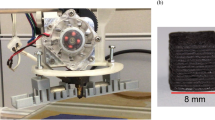Abstract
This work aims to develop magnetic fibers whose magnetic properties improve upon fibers produced using existing techniques. The goal of this work is to develop magnetic fibers that are magnetically anisotropic, with high squareness ratios when the fibers are oriented parallel to the applied magnetic field, and lower square ratios when the fibers are oriented perpendicular to the field. In this work, barium hexaferrite particles were embedded in a Sylgard elastomer matrix. The magnetic material was placed on a sheet of acrylic with spacers on opposite ends. A top sheet of acrylic was placed on the spacers. A 0.5 T permanent magnet was placed on top of the upper piece of acrylic. Magnetic fibers were drawn as the material aligned itself with the magnetic field lines of the magnet. After the fibers cured they were tested on a vibrating sample magnetometer at angles parallel and perpendicular to the field. The results showed that the fibers were highly anisotropic, with an average squareness ratio of 0.82 in the easy axis and an average squareness ratio of 0.34 in the hard axis. Although, the fibers were anisotropic, there was a high variability in the magnetization when normalized by the total volume of the fiber. This indicates that the magnetic content varies within each fiber, likely due to the variation in the strength of the magnetic field lines of the external magnet. This research demonstrated that magnetic fibers with high anisotropy can be fabricated, but the amount of magnetic material in each fiber from the same batch needs to be tuned to decrease variability. Fitting this experimentally found squareness ratio to a von Mises distribution, the concentration parameter was calculated to be 0.14. This indicates the magnetic domains within each fiber are highly aligned with the externally applied field.
Similar content being viewed by others
References
C. Breznak and P.V. Lockette, MRS Adv. MRS Advances 1, 39 (2016).
G.F. Liu, R.H. Fan, K.L. Yan, X.A. Wang, K. Sun, C.B. Cheng, and Q. Hou, Materials Science Forum 815, 141 (2015).
X. Jing, X. Shen, H. Song, and F. Song, Journal of Polymer Research 18, 2017 (2011).
F. Song, X. Shen, J. Xiang, and H. Song, Materials Chemistry and Physics 120, 213 (2010).
R. Pullar and A. Bhattacharya, Journal of Magnetism and Magnetic Materials 300, 490 (2006).
Y. Wang, Y. Gao, H.M. Wyss, P.D. Anderson, and J.M. den Toonder, Microfluidics and Nanofluidics 18, 167 (2015).
P. Saxena, J.-P. Pelteret, and P. Steinmann, European Journal of Mechanics - A/Solids 50, 132 (2015).
T.C. Gasser, R.W. Ogden, and G.A. Holzapfel, Journal of The Royal Society Interface 3, 15 (2006).
S.R. Mishra, M.D. Dickey, O.D. Velev, and J.B. Tracy, Nanoscale 8, (2015)
Author information
Authors and Affiliations
Rights and permissions
About this article
Cite this article
Breznak, C., von Lockette, P. Anisotropic Magnetic Fibers Produced via a Magnetic Drawing Process. MRS Advances 2, 921–926 (2017). https://doi.org/10.1557/adv.2017.114
Published:
Issue Date:
DOI: https://doi.org/10.1557/adv.2017.114




